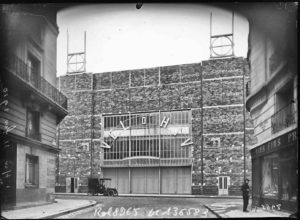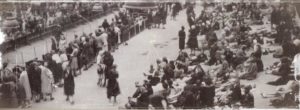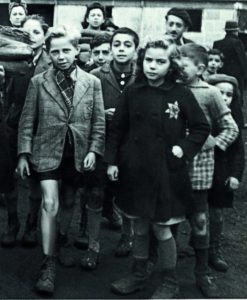 I have made it almost 4 decades without the date July 16th evoking any real emotion in me. But this year there is a somber angst in my soul. This year, the anniversary of the Vel d’Hiv Roundup haunts me like a heavy regret. I find myself staring at black and white photographs of people being dragged from their homes, corralled like cattle into buses that would land them, along with thousands of other innocent
I have made it almost 4 decades without the date July 16th evoking any real emotion in me. But this year there is a somber angst in my soul. This year, the anniversary of the Vel d’Hiv Roundup haunts me like a heavy regret. I find myself staring at black and white photographs of people being dragged from their homes, corralled like cattle into buses that would land them, along with thousands of other innocent
victims, imprisoned in the Velodrome for the next week with very little food or water and without lavatories.
As I sit here researching pictures and articles depicting some of France’s darkest times, I am astonished and embarrassed by my lack of knowledge of what took place on those hot July days some 74 years ago in Paris. Just blocks away from the towering majesty and watchful eye of the Eiffel Tower lays a plot of land that if it could talk, would tell secrets of mankind’s ability to dehumanize and to hate. It would whisper dark horrors in the still of night, the kind that make you long to wake-up and realize with acute relief that it was all just a dream. The kind that begs your heart to slow its beat and causes you to check in on loved ones.
The Velodrome d’Hiver (Winter Velodrome) also known as the Vel d’Hiv, once an indoor cycling track hosting bike enthusiasts, became a place of imprisonment and isolation as French policeman rounded up close to 11,000 Jews that first day. Children between the ages of 2-16, along with their parents, were arrested and dragged from their homes. The twisted irony being that although many Jews had been  forewarned of the danger, they believed the deportation would target only men, as it had in the past. Consequently, the women and children did not go into hiding. This made “Operation Spring Breeze,” the repulsing code name for this cruel and inhumane act, a success. In the course of two days, over 13,000 Jews were arrested and held captive in the Velodrome.
forewarned of the danger, they believed the deportation would target only men, as it had in the past. Consequently, the women and children did not go into hiding. This made “Operation Spring Breeze,” the repulsing code name for this cruel and inhumane act, a success. In the course of two days, over 13,000 Jews were arrested and held captive in the Velodrome.
In the week following the arrests, Jews were taken from the Velodrome to the concentration camps of Pithiviers, Beaune-la-Rolande and Drancy. At the end of July and beginning of August, the Jews being held in these camps were separated from their children and deported. Mothers clung to their children, holding on in desperation as police officers ripped them from their grasp. Mental pictures were taken as parents and children alike tried to sear their loved one’s faces into their memories. For many, this was the last time they would ever see their family again.
Before deportation, each prisoner’s head was shaved and his or her body subjected to a violent search, thereby stripping them not only of their hair and clothing, but also of their dignity. By the end of September 1942, almost 38,000 Jews had been deported to Auschwitz from France. In 1945, only around 780 of them remained alive.
And of course this is only one sliver in the overall story of the Holocaust. So many lives were lost, so many futures cut short. And my heart implores my mind to make sense of it all. I try to come up with something to make the gnawing sick feeling in my gut go away. I wrestle with questions that have no answers.
 What I do believe is this: It matters deeply that we care.
What I do believe is this: It matters deeply that we care.
It matters that I feel sick to my stomach over it and that I talk to my children about what happened on this fateful day. It matters that we take time to remember. To wrestle with our grief, our pain and our loss. When we are able to connect our pain and loss to someone else’s our hearts become entangled as well. And it’s nearly impossible to hate someone you have let into your heart.
It seems so simple. Little. And not near enough. When in truth, it’s the biggest, bravest thing we can do.
We can care. We can love. And we can never forget.

Please note: I reserve the right to delete comments that are offensive or off-topic.